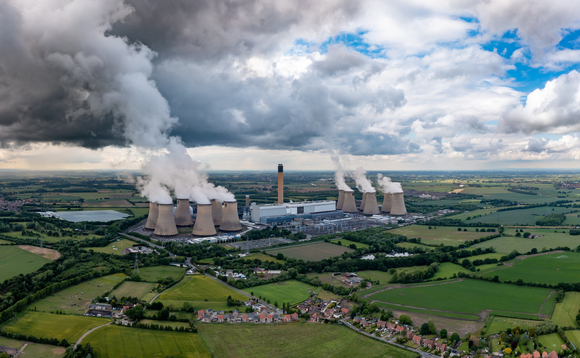
Carbon Brief analysis of preliminary data suggests UK territorial emissions fell for the ninth time in 10 years in 2022, but much work remains to bring country into line with net zero goals
UK greenhouse gas emissions fell 3.4 per cent last year, as a growing reliance on clean energy and a further decline in coal power helped bring an end to the 2021 rebound in emissions that followed the Covid-19 pandemic, according to a new analysis of preliminary data released today.
While the economy grew 4.1 per cent in 2022 as the post-pandemic recovery gathered pace, UK territorial emissions fell for the ninth year in the past decade, meaning that overall the UK's greenhouse gas emissions are now 49 per cent lower than they were in 1990, edging the country closer to its 2030 goal to slash emissions by 68 per cent.
The analysis, carried out by Carbon Brief, is based on preliminary government data and shows that after pandemic-driven lockdowns sent emissions down by a record 9.8 per cent in 2020 before they then bounced back by five per cent in 2021, emissions once again fell by 3.4 per cent last year.
Carbon Brief said the decline in greenhouse gases was largely due to increases in power generation from renewables such as wind and solar, combined with declines in the use of fossil fuels across the economy.
Coal demand for power generation fell 15 per cent in 2022, reaching its lowest level for 266 years, according to the analysis. The last time UK coal emissions were as low as they were last year it was 1757 and George II was on the throne.
Moreover, coking coal used for steel production in the UK also fell to record low levels, dropping 19 per cent as domestic production of steel fell 16 per cent to its lowest level since the 1930s, further calling into question the case for opening a new coking coal mine in Cumbria.
While emissions from oil increased as road traffic returned to pre-covid levels and air traffic doubled after a similar pandemic driven slump, the rise was outweighed by the reductions in emissions from both coal and gas, according to Carbon Brief.
However, it stressed UK territorial emissions could have risen last year were it not for higher than average temperatures that were 0.9C above normal, which led to a reduction in demand for heat and power from buildings in 2022, and therefore emissions.
In addition, strong growth in power generation from wind and solar power last year, thanks to record high capacity and a bounce back from the decade-low wind speeds seen in 2021, further helped to drive down fossil fuel use last year, the analysis found. The strong performance from wind and solar came in addition to smaller increases in power generation from hydro, solar, nuclear, and gas.
As a result, the UK became a net exporter of electricity last year for the first time since 1978, in part due to downturns in production from nuclear and hydropower across the continent.
Carbon Brief said it was feasible that further cuts in UK emissions could be achieved in 2023, thanks to weak economic growth, the continued expansion in wind and solar power generation, and more imports of power from Europe.
However, it warned that without warmer than average weather last year coupled with strong growth in renewable energy production, UK greenhouse gas emissions would have risen again last year, rather than declined.
As such, it stressed that with UK coal production having driven much of the significant reduction in emissions over the past decade, and with coal power now at such low levels, the government urgently needs to take action across other key areas of the economy to hit climate goals going forward.
"This analysis highlights the fragility of UK emissions reductions in 2022, only parts of which were due to deliberate climate action," Carbon Brief said. "The UK cannot hope to achieve its targets on the back of cyclical swings in temperature and weak demand caused by a once-in-a-generation global energy crisis."
As such it echoed calls from green groups, trade associations, and the government's own climate advisors for more action to curb emissions in areas such as buildings, transport, industry, and agriculture.
It comes as the government faces significant pressure from all flanks to increase its climate ambitions and put further flesh on the bones of its net zero agenda over the coming months, beginning with the Spring Budget on 15 March and an expected revamped Net Zero Strategy before the end of the month.
There are fears within government and right across the economy that the hundreds of billions of dollars in green subsidies and incentives unveiled in the US Inflation Reduction Act (IRA) could serve to tempt coveted global green investment to America, while the EU has also sought to respond with its own green policy and fundings efforts aimed at attracting clean tech investment to Europe.
Meanwhile, it emerged over the weekend that Cabinet Ministers have been warned that the UK's failure to come forward with more policy detail and actions in support of it its net zero agenda risks the government facing further court action.
Leaked Whitehall briefings to government ministers seen by The Observer reportedly make clear that government has failed to adequately spell out how it plans to achieve its near and long term legally-binding net zero targets.
The documents reportedly show that Defra is the furthest behind in its net zero policies, while the Department for Transport currently has a green policy gap that is "considerably over five per cent", according to the newspaper.
The UK government has said it plans to offer a policy response to both the US IRA and the EU's green industrial strategy in order to attract much needed green investment, while the Chancellor Jeremy Hunt had also promised a "fulsome response" to Chris Skidmore's recent Net Zero Review in the spring or early summer this year.